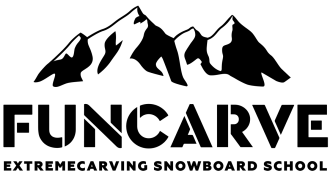Carving technique. Down-unweighting
This is the way of transferring from one edge to another which allows using short turns more confidently and without loss of control. It is characterized by low body position already in the beginning of the turn.
The technique of inclinations has several shortcomings:
- When running across roughness slope on straightened legs you remove your weight from the edge of the board and for a moment you lose control over the board;
- In the final phase of the carve when you are approaching the perpendicular position relatively to the slope the weight of your body continues to move down pushing your board to the snow and increasing the friction significantly;
- Transfering from one edge to another is relatively slow;
- There is a certain threshold of speed and depth of inclination behind which you go up from your inclination so quickly that power of inertia is created which separates the board from snow and the contact between them get lost;
The main task of down-unweighting as a kind of vertical motion is the change of the edge. Also it provides maximum control over the board in any moment because your body is always at the same distance from snow. Besides unlike up-unweighting in this case the contact between your board and snow is kept almost all the time even in moments of changing the edge.
The phase of turn
Right after you changed the edge your knees are bent, your weight is distributed 50:50 between your legs. Next you have to straighten your knees smoothly until the desired moment of edge change. Remember that any vertical motion should be performed during the whole phase of turn! Too early or too harsh straightening of legs decreases the efficiency of down-unweighting as a kind of vertical motion.
Edge change
To change the edge you need to bend your knees harshly thereby removing your weight from the edge and to direct your body to the side of the next turn. Right in the beginning of the next turn your weight should be 50:50 again and your knees should be bent.
Attention!
You shouldn’t bend your knees ‘BEFORE’, ‘DURING’ or ‘AFTER’
You should bend your knees ‘FOR’ edge change!
As you see depending on your preferences you can bend your knees in wide time range and this is why down-unweighting is so comfortable – when you want to change the direction of your motion simply pull your legs, your board unweightens and you change the edge. It is very important to bend your knees without bending your back otherwise it will cause disbalance on the board. All that you need to think about at the moment of edge change is: bending your legs and keeping your back straight!
- The smoother you unbend your knees and the faster you bend them the lesser losses of speed will be;
- You can control your speed by increasing or reducing the phase of high friction;
- The combination of down-unweighting with rotation allows achieving extremely deep inclination in turn what is called Extremecarving;
- Push-n-Pull technique is the modification of down-unweighting and it was renamed for better understanding of the movements used in it.



